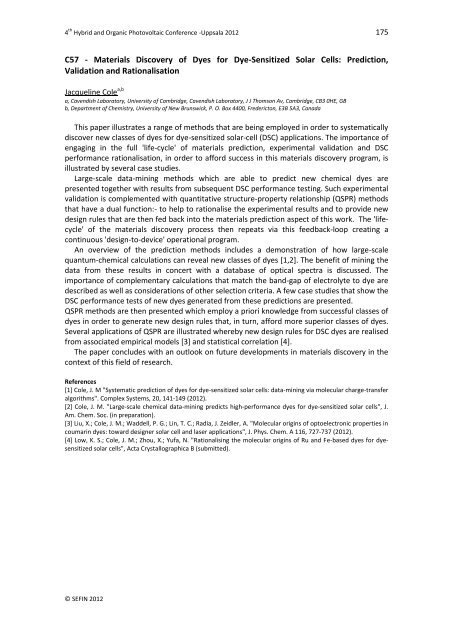HOPV12 - Blogs
HOPV12 - Blogs
HOPV12 - Blogs
You also want an ePaper? Increase the reach of your titles
YUMPU automatically turns print PDFs into web optimized ePapers that Google loves.
4 th Hybrid and Organic Photovoltaic Conference -Uppsala 2012 175<br />
C57 - Materials Discovery of Dyes for Dye-Sensitized Solar Cells: Prediction,<br />
Validation and Rationalisation<br />
Jacqueline Cole a,b<br />
a, Cavendish Laboratory, University of Cambridge, Cavendish Laboratory, J J Thomson Av, Cambridge, CB3 0HE, GB<br />
b, Department of Chemistry, University of New Brunswick, P. O. Box 4400, Fredericton, E3B 5A3, Canada<br />
This paper illustrates a range of methods that are being employed in order to systematically<br />
discover new classes of dyes for dye-sensitized solar-cell (DSC) applications. The importance of<br />
engaging in the full 'life-cycle' of materials prediction, experimental validation and DSC<br />
performance rationalisation, in order to afford success in this materials discovery program, is<br />
illustrated by several case studies.<br />
Large-scale data-mining methods which are able to predict new chemical dyes are<br />
presented together with results from subsequent DSC performance testing. Such experimental<br />
validation is complemented with quantitative structure-property relationship (QSPR) methods<br />
that have a dual function:- to help to rationalise the experimental results and to provide new<br />
design rules that are then fed back into the materials prediction aspect of this work. The 'lifecycle'<br />
of the materials discovery process then repeats via this feedback-loop creating a<br />
continuous 'design-to-device' operational program.<br />
An overview of the prediction methods includes a demonstration of how large-scale<br />
quantum-chemical calculations can reveal new classes of dyes [1,2]. The benefit of mining the<br />
data from these results in concert with a database of optical spectra is discussed. The<br />
importance of complementary calculations that match the band-gap of electrolyte to dye are<br />
described as well as considerations of other selection criteria. A few case studies that show the<br />
DSC performance tests of new dyes generated from these predictions are presented.<br />
QSPR methods are then presented which employ a priori knowledge from successful classes of<br />
dyes in order to generate new design rules that, in turn, afford more superior classes of dyes.<br />
Several applications of QSPR are illustrated whereby new design rules for DSC dyes are realised<br />
from associated empirical models [3] and statistical correlation [4].<br />
The paper concludes with an outlook on future developments in materials discovery in the<br />
context of this field of research.<br />
References<br />
[1] Cole, J. M "Systematic prediction of dyes for dye-sensitized solar cells: data-mining via molecular charge-transfer<br />
algorithms". Complex Systems, 20, 141-149 (2012).<br />
[2] Cole, J. M. "Large-scale chemical data-mining predicts high-performance dyes for dye-sensitized solar cells", J.<br />
Am. Chem. Soc. (in preparation).<br />
[3] Liu, X.; Cole, J. M.; Waddell, P. G.; Lin, T. C.; Radia, J. Zeidler, A. "Molecular origins of optoelectronic properties in<br />
coumarin dyes: toward designer solar cell and laser applications", J. Phys. Chem. A 116, 727-737 (2012).<br />
[4] Low, K. S.; Cole, J. M.; Zhou, X.; Yufa, N. "Rationalising the molecular origins of Ru and Fe-based dyes for dyesensitized<br />
solar cells", Acta Crystallographica B (submitted).<br />
© SEFIN 2012


